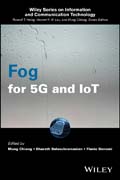
The book examines how Fog will change the information technology industry in the next decade. Fog distributes the services of computation, communication, control and storage closer to the edge, access and users. As a computing and networking architecture, Fog enables key applications in wireless 5G, the Internet of Things, and big data. The authors cover the fundamental tradeoffs to major applications of fog. The book chapters are designed to motivate a transition from the current cloud architectures to the Fog (Chapter 1), and the necessary architectural components to support such a transition (Chapters 2–6). The rest of the book (Chapters 7–xxx) are dedicated to reviewing the various 5G and IoT applications that will benefit from Fog networking. This volume is edited by pioneers in Fog and includes contributions by active researchers in the field. Covers fog technologies and describes the interaction between fog and cloud Presents a view of fog and IoT (encompassing ubiquitous computing) that combines the aspects of both industry and academia Discusses the various architectural and design challenges in coordinating the interactions between M2M, D2D and fog technologies Fog for 5G and IoT serves as an introduction to the evolving Fog architecture, compiling work from different areas that collectively form this paradigm Mung Chiang is the Arthur LeGrand Doty Professor of Electrical Engineering at Princeton University, the Director of the Keller Center for Innovations in Engineering Education, and the Chair of Princeton Entrepreneurship Advisory Committee. Dr. Chiang founded the Princeton EDGE Lab in 2009, which bridges the theory–practice gap in edge networking research by spanning from proofs to prototypes. He is the recipient of the 2013 Alan T. Waterman Award. Bharath Balasubramanian is a distributed systems researcher in the Cloud Software Research department at ATT Labs. Prior to this, he had a postdoc in the Electrical Engineering department at Princeton University working with Mung Chiang in the EDGE lab. Flavio Bonomi is a Cisco Fellow, Vice President, and is the Head of the Advanced Architecture and Research Organization at Cisco Systems. INDICE: List of Contributors .Introduction Bharath Balasubramanian, Mung Chiang and Flavio Bonomi .Part I. Communication and Management of Fog .1. ParaDrop: An edge computing platform in home gateways Suman Banerjee, Peng Liu, Ashish Patro, Dale Willis .1.1 Introduction .1.2 Implementing services for the ParaDrop platform .1.3 Develop services for ParaDrop .References .2. Mind Your Own Bandwidth Carlee JoeWong, Sangtae Ha, Zhenming Liu, Felix Ming Fai Wong, and Mung Chiang .2.1 Introduction .2.2 Related Work .2.3 Credit Distribution and Optimal Spending .2.4 An Online Bandwidth Allocation Algorithm .2.5 Design and Implementation .2.6 Experimental Results .2.7 Gateway Sharing Results .2.8 Concluding Remarks .A.1 Proof of Lemma 1 .A.2 Proof of Lemma 2 .A.3 Proof of Proposition 1 .A.4 Proof of Proposition 2 .A.5 Proof of Proposition 3 .A.6 Proof of Proposition 4 [Note to Production: These appendixes can be combined into a single appendix] .3. Socially–aware Cooperative D2D and D4D Communications towards Fog Networking Xu Chen, Junshan Zhang, and Satyajayant Misra .3.1 Introduction .3.2 Related work .3.3 System Model .3.4 Socially–aware Cooperative D2D and D4D Communications towards Fog Networking .3.5 Network Assisted Relay Selection Mechanism .3.6 Simulations .3.7 Conclusion .Acknowledgements .References .4. You deserve better properties (from your smart devices) Steven Y. Ko .4.1 Why We Need To Provide Better Properties .4.2 Where We Need To Provide Better Properties .4.3 What Properties We Need to Provide and How .4.4 Conclusions .Acknowledgements .References .Part II. Storage and Computation in the Fog: .5. Distributed Caching for Enhancing Communications Efficiency A. Salman Avestimehr and Andy Molisch .5.1 Introduction .5.2 Femtocaching .5.3 Usercaching .5.4 Conclusions and outlook .References .6. Wireless Video Fog: Collaborative Live Streaming with Error Recovery Bo Zhang, Zhi Liu, and S.–H. Gary Chan .6.1 Introduction 2 .6.2 Related Work 5 .6.3 System Operation and Network Model 6 .6.4 Problem Formulation and Complexity Analysis .6.5 VBCR: A Distributed Heuristic for LiveVideo with Cooperative Recovery .6.6 Illustrative Simulation Results .6.7 Concluding Remarks .References .7. Elastic MobileDevice Clouds: Leveraging Mobile Devices to Provide Cloud Computing Services at the Edge Karim Habak, Cong Shi, Ellen W. Zegura, Khaled A. Harras, and Mostafa Ammar .7.1 Introduction .7.2 Design Space with Examples .7.3 FemtoCloud Performance Evaluation .7.4 Serendipity Performance Evaluation .7.5 Challenges .References .Part III. Applications of Fog .8. The Role of Fog Computing in the Future of the Automobile Flavio Bonomi, Stefan Poledna, and Wilfried Steiner .8.1 Introduction .8.2 Current Automobile Electronic Architectures .8.3 Future Challenges of Automotive E/E Architectures and Solution Strategies .8.4 Future Automobiles as Fog Nodes on Wheels .8.5 Deterministic Fog Nodes on Wheels through Real–Time Computing and Time–Triggered Technologies .8.6 Conclusion .References .9. Geographic Addressing for Field Networks Robert J. Hall .9.1 Introduction .9.2 Geographic Addressing .9.3 SAGP: Wireless GA in the Field .9.4 Georouting: Extending GA to the Cloud .9.5 SGAF: a multi–tiered architecture for large scale GA .9.6 The AT&T Labs Geocast System .9.7 Two GA Applications .9.8 Conclusions .References .10. Distributed Online Learning and Stream Processing for a Smarter Planet Deepak S. Turaga and Mihaela van der Schaar .10.1 Introduction: Smarter Planet .10.2 Illustrative Problem: Transportation .10.3 Stream Processing Characteristics .10.4 Distributed Stream Processing Systems .10.5 Distributed Online Learning Frameworks .10.6 What Lies Ahead .10.7 Acknowledgement .References .11. Securing the Internet of Things: Need for a New Paradigm and Fog Computing Tao Zhang, Yi Zheng, Raymond Zheng, and Helder Antunes .11.1 Introduction .11.2 New IoT Security Challenges that Necessitate Fundamental Changes to the Existing Security Paradigm .11.3 A New Security Paradigm for the Internet of Things .11.4 Summary .Acknowledgement .References
- ISBN: 978-1-119-18713-4
- Editorial: Wiley–Blackwell
- Encuadernacion: Cartoné
- Páginas: 288
- Fecha Publicación: 11/05/2017
- Nº Volúmenes: 1
- Idioma: Inglés
